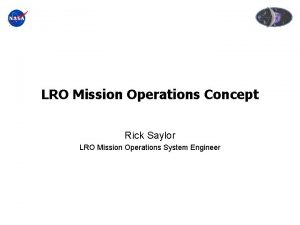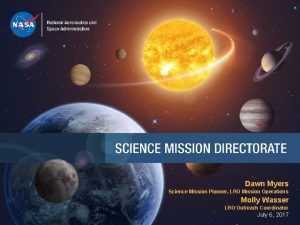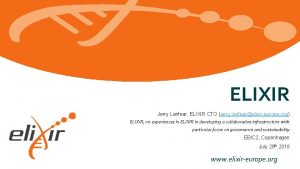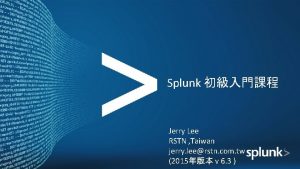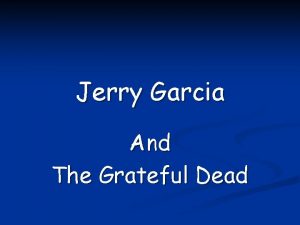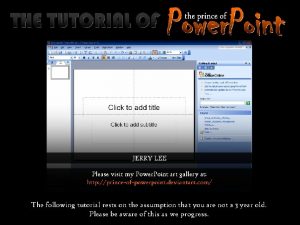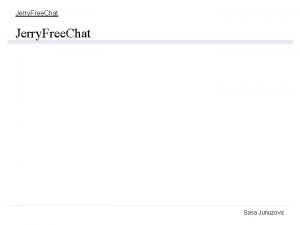LRO Operations at the MLRS Jerry R Wiant










- Slides: 10

LRO Operations at the MLRS Jerry R. Wiant Randall L. Ricklefs Peter J. Shelus Center for Space Research and Mc. Donald Observatory The University of Texas at Austin 14 October 2008 16 th International Workshop on Laser Ranging 1

Introduction The Lunar Reconnaissance Orbiter (LRO) will perform laser altimetry of the moon and improve lunar gravity field modelling. To augment orbital accuracy for lunar gravity field mapping, one-way laser ranging is needed to provide several-cm position accuracy. MLRS is one of the primary laser stations that will track LRO. MLRS pointing, tracking, beam-divergence, software, and procedural issues must be resolved prior to the early-2009 launch. 14 October 2008 16 th International Workshop on Laser Ranging 2

Hardware Issues - 1 Pointing and tracking LRO will not be visible in the MLRS telescope, so accurate blind pointing is required. Absolute pointing of the MLRS telescope is around 10 arcsec. Pointing to LRO will be improved (to 1 -2 arcsec) by offsetting from lunar features, possibly using the XY stage. MLRS can hands-off track high satellites to a few arcseconds over 15 minutes. Observer will recenter with lunar features as needed for 60 minute LRO “passes. ” 14 October 2008 16 th International Workshop on Laser Ranging 3

Hardware Issues - 2 Energy delivered to spacecraft Critical to safety of LOLA detectors Depends on laser energy, seeing, and beam divergence Beam divergence (controlled by defocus of MLRS telescope) has been poorly known Ranging high satellites (Glonass) using high laser energy and high detector amplification while manually scan through the laser beam along track and cross track gives us beam divergence. 14 October 2008 16 th International Workshop on Laser Ranging 4

Hardware Issues - 3 Energy delivered to spacecraft (cont. ) Tests with collimated beam showed beam-width at the space craft matches seeing estimate. Tests with LAGEOS-level defocussed beam, showed a beam divergence of xx arcsec. Tests with LEO defocussing gave yy arcsec. Using LEO beam divergence and LEO power will deliver proper power at LRO. [TBD for sure] 14 October 2008 16 th International Workshop on Laser Ranging 5

Hardware Issues - 4 Optimal fire rate for LRO is 28 Hz, synchronized with the satellite. However, MLRS will fire at 10 Hz as usual. The ranging detector will be used during LRO ranging to gather internal calibration data and the firing time. Laser wavelength tests have confirmed compatibility with LRO/LOLA detector. 14 October 2008 16 th International Workshop on Laser Ranging 6

Acquisition System Software Tasks Allow any target to be treated like an LLR or SLR target through a set-up file (to allow lunar feature offset pointing for LRO). Done. Pass CPF file “target type” (slr, llr, xponder) through raw data to trigger transponder processing in reduction software. Done. Read and act on LRO go/no-go flag. Done. 14 October 2008 16 th International Workshop on Laser Ranging 7

Reduction System Software Tasks Download and process LRO predictions and schedule. Done. Recognize LRO by “target type” in raw data. Done. Apply one-way calibrations. Investigating. Convert LRO data to CRD. Done as part of CRD conversion. Send LRO data to HTSI. No change. 14 October 2008 16 th International Workshop on Laser Ranging 8

Procedure Changes Check integrated target schedule for LRO availability (1 hour out of every 2 while moon is above horizon). Manually set laser power and focus to LRO values. Use LRO website for operator pointing feedback, as there are no returns from LRO. 14 October 2008 16 th International Workshop on Laser Ranging 9

Conclusion Our build-up to LRO tracking has required addressing lingering questions about MLRS's pointing, tracking, and beam divergence Once these questions were/are answered, LRO tracking mainly impacts software and procedures 14 October 2008 16 th International Workshop on Laser Ranging 10










